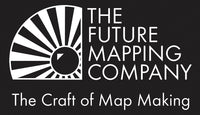Women who shaped the world: Barbara Petchenik
The elegant Robinson Projection was named after its creator, Arthur Robinson, but, is there another uncredited female Cartographer who also deserves some of the acclaim?
Who was Barbara Petchenik?
Barbara Bartz Petchenik was the first woman to serve as Vice President of the International Cartographic Association, she participated in numerous of their projects and edited the major atlas (Atlas of Early American History) . She is among a number of pioneering women who contributed significantly to modern cartography, yet whose important work is frequently overlooked or under-researched.
Barbara is remembered predominantly for her interest and research into the theme of children's maps and atlases, perhaps an area considered most appropriate for a woman's expertise to lie. But this is by no means the only area that she specialised. From 1962 - 1992, she contributed to about 60 articles, papers, reviews and other map related research specialising in cartographic typography and type legibility, communication aspects, historical cartography and the psychological aspects of map design to name a few.
Most significantly, she worked closely with her friend and mentor Arthur Robinson, the cartographer of the Robinson Projection, on the leading mapping book The Nature of Maps. They also co-wrote two works about Communications Aspects, one of which, 'The Map as a Communication System', was award winning. The closeness with which the pair worked has led to speculation that she may have even played an important, though un-credited, role in the creation of the Robinson Projection.
WHAT IS THE ROBINSON PROJECTION?
The Robinson projection was devised in 1963 in response to an appeal from an American mapping software company, Randy McNally, which has used the projection in general purpose world maps since that time. It was specifically created in an attempt to find a good compromise to the problem of readily showing the whole globe as a flat image.
The map is known as a ‘compromise’, it shows neither the shape or land mass of countries correctly - see above. Arthur Robinson developed it using a more visual trial and error development. “I visualised the best-looking shapes and sizes. I worked with the variables, until it got to the point where, if I changed one of them, it didn’t get any better.” It was only at this point that he worked out the mathematical formula. The curved meridians, give it a nice spherical look. So nice, in fact, that it is the projection we use for our classic world maps!
This sort of trial and error method would most certainly have benefited from the input of a trusted colleague and researcher. In 1962 published Barbara published her first article 'New Map and Air Photo Library Established', signed Barbara Bartz, Map Librarian. In the two following years she wrote unpublished articles on the subjects of dot map perception and tellingly, 'The figure-ground relationship: it's role in Cartographic design.'
Why should we learn more about Barabara Petchnik's work?
Before and after her death in 1992, several articles were written about Barbara, her literary output on the subject of maps was so beyond what would usually be expected of someone working for a commercial, rather than academic, post. However, sadly, no attempt was made to compare her to other cartographers of her time, though her work certainly merits it.
The role of women in the history of map making has been consistently 'left out' for various reasons - read our blog post about other female Cartographers history forgot here - and though we may never know the full story, greater research into Barbara's work and the possibility of her having a role in the creation of Robinson Projection is certainly overdue.








